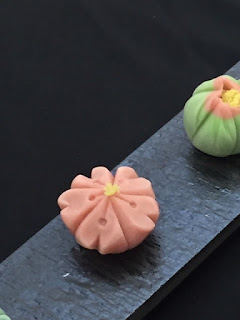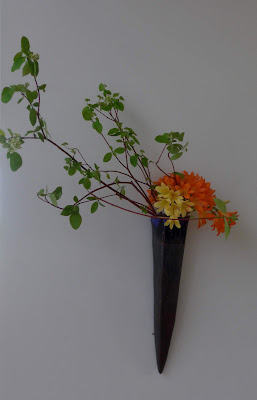LOVE FLOWER
 |
| A different angle |
 |
| John and I giving an idea of scale |
 |
| Night view with the lights on |

Hello all,
Well, it's been quite an eventful week, culminating in the official unveiling of the sculpture, Love Flower, with which I have been involved.
Below is the media release which describes the project better than I can.
New
Public Sculpture: Southern Way McClelland Commission
Melbourne’s cultural landscape has an exciting new
addition. The next instalment of the $250,000 Southern Way McClelland biennial
sculpture commission has been revealed. Artist John
Meade, with Emily Karanikolopolous, was awarded the commission for his elegant and
enchanting sculpture, Love Flower, which is based on an
Ikebana flower arrangement design. The sculpture has replaced Gregor Kregar’s Reflective
Lullaby that was located at Cranbourne Road, on the Langwarrin exit ramp
close to McClelland Sculpture Park+Gallery.
Love Flower is sited along the
Peninsula Link freeway in Melbourne’s South East as part of a unique and
award-winning commitment to public art. Established in 2013 as a Public Private
Partnership between Southern Way and McClelland Sculpture Park and Gallery, this ongoing program of iconic artworks has
established the Mornington Peninsula as an internationally significant hub for
public art and contemporary sculpture. The series alternates every two years between sites at Skye Road and Cranbourne Road along Peninsula Link, which will result in 14 commissions over a 25-year
period to 2037. Southern Way generously
donates funding for the sculptures. After four years on public display the
commissions become part of McClelland’s permanent sculpture collection in its
8-hectare sculpture park in Langwarrin.
“The fifth in
this highly regarded series of Southern Way McClelland Commissions, Love
Flower is beautiful and awe inspiring. As public sculpture this work
engages in ways with the aesthetics of nature, as well as being an absolutely magical
sight for all who pass by,” says Lisa Byrne, Director, McClelland Sculpture
Park+Gallery.
Simon
Lawrie, The Balnaves Curator of Australian Sculpture at McClelland, says “As iconic
public artworks, these sculptures enliven our community and our daily commute,
and encourage discussion about art and ideas – Love Flower is bound to enchant locals and visitors to the
Mornington Peninsula alike.’
The Southern
Way McClelland Commission 2018 received 65 submissions from local,
interstate and international artists. The commission judging panel was Lisa
Byrne, Director, McClelland Sculpture Park+Gallery, Maudie Palmer AO, former
inaugural Director of Heide Museum of Modern Art and TarraWarra Museum of Art;
and artist Lisa Roet.
John Meade is a renowned contemporary
Australian sculptor, whose practice draws relations, often humorous and
unexpected, between the metaphysical and surreal in the experience of
contemporary life and domestic culture. He was born in Ballarat in 1956 and
currently lives and working in Melbourne. Meade has exhibited widely both nationally
and internationally, and his work is held in major private and public
collections throughout Australia. He is represented by Sutton Gallery,
Melbourne.
Emily Karanikolopoulos is an
Australian artist who is a teacher and practitioner of the Japanese floral
arrangement art of Sogetsu Ikebana. She is an active member of the Ikebana
community of Australia, and she has attained the highest possible Ikebana
accreditation outside Japan.
Lisa Byrne,
Director, McClelland Gallery+Sculpture Park and Simon Lawrie, The Balnaves
Curator of Australian Sculpture are available for interview, as are the
artists.
McClelland Sculpture Park+Gallery, 390
McClelland Drive, Langwarrin.
And just a brief history of how it came about.
In January, 2016 I received an email from from John Meade, an artist of some repute and lecturer at Monash University. He had seen one of my arrangements on the Sogetsu website and was curious about the material I had used.
I explained that they were dried agapanthus flower heads that had been sprayed. I was under the impression that he wanted to know how to grow the curved stems himself. I was wrong. John contacted me later and we met, got to know each other and, long story short, he asked me if I would be interested in collaborating with him in a sculpture that he wanted to make in the shape of an agapanthus. Well, of course I was! But, seriously, not in my wildest dreams did I think that we would end up with a sculpture ten metres high. This was all John's vision.
I have a very large patch of agapanthus and when they are in flower, they are magnificent. I've been experimenting with manipulating their growth and creating interesting, curved shapes of the stems. I choose a young flower head whilst it is still soft and malleable and bend it, holding it down with a fork. Then nature takes over, with the flower wanting to grow towards the sun, thus creating the curves.
I grew one such flower over a bent wire to create a kind of spiral shape. This took an entire growing season and then we had to wait for the flower to dry on the plant, otherwise it would rot. Neither John nor I was happy with the result, so we ditched it and started looking through my horde of dried flower heads. When I took out two such flowers that I had used together in an arrangement, we both said a resounding "YES". This was to be our shape. As for the name, 'agapanthus' is Greek for love flower.
When John contacted me telling me that he thought we should apply for a $250,000 Southern Way McClelland commission, I thought it was ambitious but 'nothing ventured, nothing gained'. Imagine my surprise and delight when he told me we were front runners!
John was an excellent project manager, overseeing the many different aspects of the whole project and bringing it to fruition. Friday was a great day and will remain as a real highlight in my life. The channel 9 News crew were there and it was featured in Friday's evening news. For those, who may want to see that segment, I have included the link, below.
https://www.facebook.com/9NewsMelbourne/videos/love-flower/788350124917897/
After the unveiling, those of us who were closely involved with this project were invited to a sumptuous lunch at McClelland Sculpture Park and Gallery. In my desire to contribute to the festivities, I volunteered to make some ikebana arrangements to be displayed at the gallery, to tie in with the original concept of the sculpture.
 |
| Referencing Love Flower at the entry of the Gallery |
The next two large arrangements were on plinths in the Function Room, where we had our lunch and, which became conversation pieces.
 |
| Pine (Pinus Radiata) and viburnum opulus in ceramic vase |
 |
| Strelitzia nicolai and silk fabric in two heavy containers, necessary to hold the very heavy flowers. |
https://www.mcclellandgallery.com/https://www.mcclellandgallery.com/
Bye for now,
Emily







































